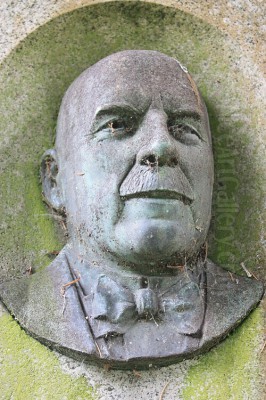
Robert Gemmell Hutchison stands as a significant figure in Scottish art during the late nineteenth and early twentieth centuries. Born in Edinburgh on July 1, 1855, and passing away in the same city on August 22, 1936, Hutchison carved a niche for himself with his sensitive portrayals of domestic life, childhood innocence, and the rugged beauty of the Scottish coastline. His work, primarily executed in oil, resonates with warmth, keen observation, and a masterful handling of light, earning him considerable acclaim during his lifetime and a lasting place in the narrative of Scottish painting.
Early Life and Artistic Formation
Hutchison's artistic journey began in his native Edinburgh. He received his formal training at the Board of Manufactures School of Art, a key institution in the city's artistic development. This period provided him with a solid foundation in drawing and painting techniques. While detailed records of his early influences are sparse, the artistic environment of Edinburgh at the time was vibrant, still feeling the impact of earlier Scottish masters and increasingly aware of continental European trends. Figures like George Paul Chalmers, known for his atmospheric interiors and portraits, were part of the preceding generation whose legacy would have been felt.
It is likely that during his formative years, Hutchison absorbed the prevailing tastes for realism and narrative painting that characterized much of Victorian art. However, he soon developed a distinct voice, focusing on subjects close to his own experience and environment. Unlike some contemporaries who pursued grand historical themes or mythological subjects, Hutchison found his inspiration in the everyday lives of ordinary Scottish people, particularly women and children, and the coastal communities he frequently visited.
Development of a Distinctive Style
Hutchison's style is often characterized by its blend of realism and sentiment. He possessed a remarkable ability to capture the textures of fabrics, the play of light on surfaces, and the subtle nuances of human expression. His interior scenes, often bathed in a soft, diffused light filtering through a window, evoke a sense of quiet intimacy and domestic tranquility. There's a palpable warmth in these depictions, suggesting a deep empathy for his subjects.
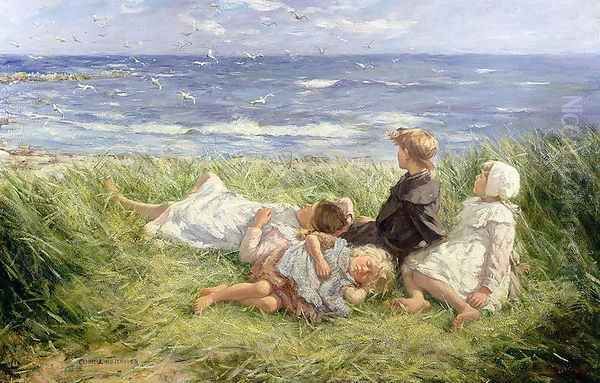
Comparisons have often been drawn between Hutchison's work and that of the Dutch Masters of the 17th century, particularly in his treatment of interior light and genre subjects. There is also a clear affinity with the painters of the Hague School in the Netherlands, such as Jozef Israëls and Anton Mauve, who similarly focused on humble domestic scenes and the lives of fisherfolk, often employing a tonal palette and an emphasis on atmosphere. Hutchison shared their interest in capturing the emotional resonance of everyday moments.
While Hutchison remained largely a representational painter, his later work sometimes shows a loosening of brushwork and a brighter palette, possibly reflecting a cautious awareness of Impressionist techniques filtering into Britain. However, he never fully embraced the Impressionist dissolution of form, preferring to maintain a strong sense of structure and narrative clarity in his compositions. His primary focus remained on capturing the essence of his subject with honesty and sensitivity.
Favourite Themes: Childhood and Coastal Life
Children were a recurring and beloved theme throughout Hutchison's career. He depicted them with tenderness and understanding, capturing their absorption in play, their quiet moments of reflection, or their interactions within the family circle. Works like A Christmas Morning exemplify this focus, presenting a scene of domestic warmth and childhood anticipation rendered with careful detail and gentle light. Another well-known work, Bairnies Cuddle Doon, evokes the comfort and security of childhood bedtime rituals.
Hutchison avoided overt melodrama, instead finding poignancy in simple, relatable moments. His depictions of children are rarely overly sentimentalized in the Victorian manner; instead, they often possess a naturalism and psychological insight that remains appealing. He seemed genuinely fascinated by the world of children, observing their postures, expressions, and activities with an affectionate eye.
Equally important to his oeuvre were his depictions of Scottish coastal life. Hutchison spent considerable time in fishing villages along the coasts of Fife, East Lothian (particularly around Dunbar and Cockenzie), Berwickshire, and Carnoustie. He painted fisherfolk, their cottages, harbours bustling with activity, and children playing on the shore. These works capture the unique atmosphere of these communities – the hardy resilience of the people, the changing moods of the sea and sky, and the specific quality of light found by the coast.
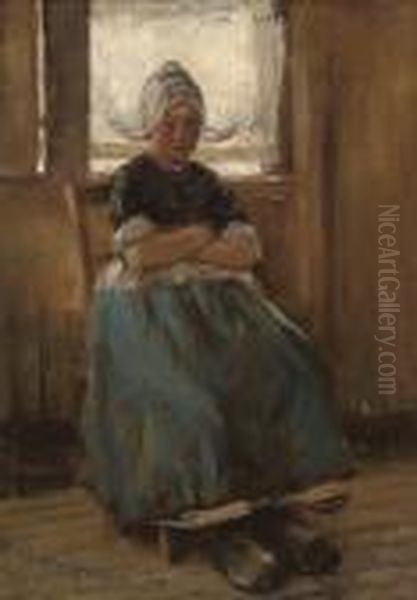
His coastal scenes often share thematic ground with the work of the great Scottish seascape painter William McTaggart, who was a generation older and a towering figure in Scottish art. While McTaggart's later style became increasingly expressive and proto-Impressionistic, Hutchison maintained a more detailed, descriptive approach. His focus was often less on the wildness of the sea itself and more on the human element within the coastal landscape. His work in this area also invites comparison with the Newlyn School painters in Cornwall, such as Stanhope Forbes and Walter Langley, who similarly documented the lives of fishing communities with realistic detail, though Hutchison's focus often leaned more towards the domestic aspects rather than the hardships of labour at sea.
Mastery of Light and Interior Scenes
One of Hutchison's most admired skills was his handling of light, particularly in interior settings. He excelled at rendering the subtle effects of daylight entering a room, illuminating figures and objects, and creating a specific mood. Works like Reflections showcase this ability, capturing the interplay of light on polished surfaces and the quiet atmosphere of a domestic space. This mastery of chiaroscuro links him again to the tradition of Dutch genre painting.
His interiors often feature women engaged in quiet domestic tasks – sewing, reading, or caring for children. These scenes are imbued with a sense of peace and dignity. The settings are typically humble but rendered with an appreciation for the beauty found in everyday objects and familiar surroundings. The careful composition and the sensitive use of light elevate these simple scenes beyond mere illustration, turning them into poetic meditations on domestic life. The influence of French Realism, particularly painters like Jules Bastien-Lepage who emphasized truthful depictions of rural life, might also be detected in the unadorned honesty of some of Hutchison's figures and settings.
Notable Works and Recognition
Throughout his long career, Robert Gemmell Hutchison produced a substantial body of work. Several paintings stand out as particularly representative or have gained significant recognition:
A Christmas Morning: Housed in the City Art Centre, Edinburgh, this oil on canvas (75cm x 63cm) is a quintessential Hutchison interior, depicting children by a window, presumably looking at presents or the weather outside. It perfectly captures his skill with light and his sympathetic portrayal of childhood.
Sea Gulls and Sapphire Seas: This work gained attention when it was sold for a respectable £150 in 1912, indicating Hutchison's market appeal during his lifetime. The title suggests a focus on the coastal environment, likely featuring his characteristic blend of seascape and perhaps figures.
Bairnies Cuddle Doon: An iconic image of childhood comfort, this work became widely known through reproductions and exemplifies his popular appeal.
Reflections: Often cited as an example of his mastery of interior light and composition.
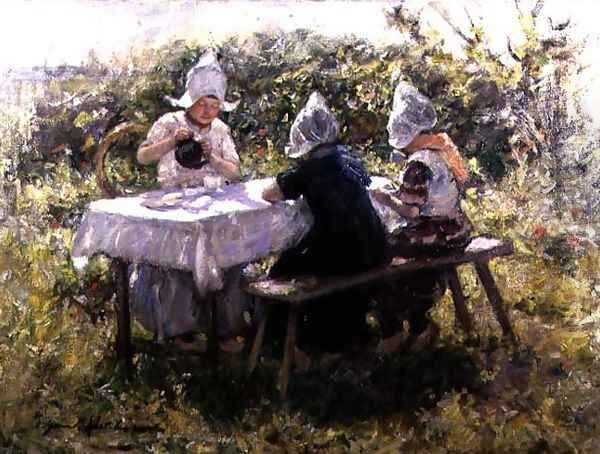
Children Wading: This painting highlights an interesting anecdote in Hutchison's legacy. It was reportedly stolen at one point but eventually recovered and returned, underscoring the value placed on his work.
The Empty Cradle: A title suggesting a more poignant or narrative subject, touching on themes of loss or absence within the domestic sphere.
The White Seam: Likely depicting a woman engaged in sewing, a common motif in his interiors, focusing on domestic labour and quiet concentration.
Janet Gordon, Wife of James Brown: A portrait (38cm x 28cm, Moat Park Heritage Centre), showing his capability in capturing likenesses, though he is less known for formal portraiture than for his genre scenes.
Evening Board: Mentioned in records, the title suggests another domestic or perhaps coastal scene set at the end of the day.
The Dead Canary: Another work indicating a narrative or sentimental theme, possibly exploring childhood grief or the fragility of life.
Hutchison exhibited widely and achieved significant professional recognition. He was elected an Associate of the Royal Scottish Academy (ARSA) in 1901 and became a full Academician (RSA) in 1911. He was also a member of the Royal Scottish Society of Painters in Watercolour (RSW) from 1895, the Royal Society of British Artists (RBA), and the Royal Institute of Oil Painters (ROI). These affiliations placed him firmly within the established art institutions of Scotland and Britain. He regularly exhibited at the RSA, the Royal Academy in London, the Glasgow Institute of the Fine Arts, and other major venues.
Hutchison in the Context of Scottish Art
Robert Gemmell Hutchison occupied a distinct position within the landscape of Scottish art at the turn of the 20th century. He was a contemporary of the Glasgow Boys, a group that included figures like Sir James Guthrie, E. A. Walton, George Henry, and James Paterson. While the Glasgow Boys were known for their embrace of French Realism and plein-air painting, often with bolder brushwork and compositions, Hutchison's style remained generally more traditional and focused on intimate subjects, though he shared their interest in light and contemporary life.
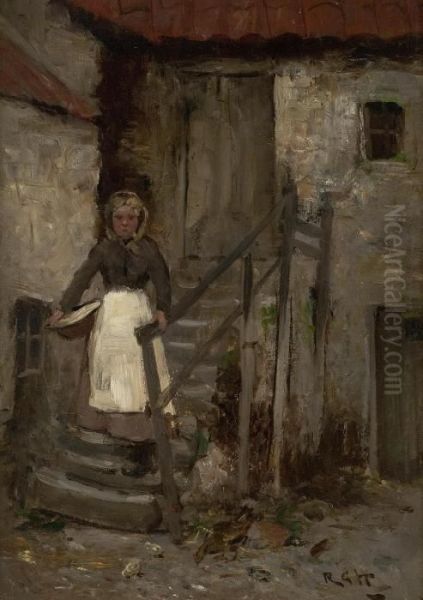
His work also ran parallel to that of artists associated with the Kirkcudbright School, such as E. A. Hornel, who also frequently depicted children, albeit often in a more decorative, colourful, and sometimes stylized manner within landscape settings. Hutchison's approach was typically more naturalistic and focused on interior or specific coastal environments.
He predated the main thrust of the Scottish Colourists – Samuel Peploe, F.C.B. Cadell, Leslie Hunter, and J.D. Fergusson – whose vibrant palettes and post-impressionist leanings represented a significant shift in Scottish painting in the early 20th century. While Hutchison's later work might show some brightening of colour, it never approached the bold experimentation of the Colourists. He remained committed to a more observational, tonal approach rooted in the 19th-century realist tradition. Another prominent contemporary, Sir David Young Cameron, achieved fame primarily through his evocative landscape etchings and paintings, representing yet another facet of the rich Scottish art scene.
Hutchison's enduring appeal lies in his ability to connect with audiences through familiar, heartwarming subjects rendered with technical skill and genuine feeling. He wasn't an avant-garde innovator in the mould of the Glasgow Boys or the Colourists, but he excelled within his chosen field of genre and coastal painting, creating a body of work that documented and celebrated aspects of Scottish life that might otherwise have been overlooked.
Wider Artistic Connections
While deeply rooted in Scotland, Hutchison's art resonates with broader European traditions. As mentioned, the connection to the 17th-century Dutch Masters and the 19th-century Hague School is significant. The focus on realism, domesticity, and the lives of ordinary working people connects him to a wider movement across Europe that sought authenticity and found dignity in everyday subjects.
The Victorian era in Britain saw a flourishing of genre painting, with artists achieving great popularity. While Hutchison's style was perhaps less overtly narrative or moralizing than some high Victorian painters like Sir Lawrence Alma-Tadema or Lord Leighton (who focused on classical scenes) or even the later works of Sir John Everett Millais, he shared the era's interest in telling stories through pictures, albeit quieter, more intimate ones. His work offers a Scottish perspective on themes that were explored across Britain and the continent. The work of female artists like Laura Knight, though often bolder in style and subject later in her career, also shared an interest in depicting everyday life and communities.
Family and Personal Tragedy
Robert Gemmell Hutchison's personal life was marked by artistic continuity and profound loss. His son, George Jackson Hutchison, born in 1890, followed in his father's footsteps and showed considerable promise as an artist. George studied art and began to exhibit, suggesting the potential for a continuing artistic dynasty. Tragically, like so many of his generation, George's life and career were cut short by the First World War. He was killed in action in 1917.
This loss undoubtedly had a deep impact on Robert Gemmell Hutchison. In memory of George, and perhaps reflecting the family's artistic interests, a prize was later established. Research suggests the "Maud Gemmell Hutchison Prize" awarded by the Royal Scottish Academy was named after Robert's second wife, Maud Gemmell Hutchison (née Pagan), who was herself an accomplished painter, particularly known for her flower studies. This prize, often awarded for works featuring animal subjects, serves as a lasting tribute within the Scottish art world connected to the Hutchison family.
Later Life and Enduring Legacy
Robert Gemmell Hutchison continued to paint and exhibit throughout the early decades of the 20th century, remaining a respected figure in the Scottish art establishment. His work retained its popularity with the public, who appreciated his accessible subjects and evident skill. He maintained his focus on the themes that had defined his career – the gentle moments of childhood, the quiet dignity of domestic life, and the evocative atmosphere of the Scottish coast.
He passed away in Edinburgh in 1936 at the age of 81. Today, his paintings are held in numerous public collections across Scotland and the UK, including the National Galleries of Scotland, the Edinburgh City Art Centre, the Hunterian Art Gallery in Glasgow, and various municipal collections. His work continues to appear at auction, where his gentle interiors and charming depictions of children remain sought after.
Robert Gemmell Hutchison's contribution to Scottish art lies in his role as a sensitive chronicler of his time and place. He captured a world of domestic intimacy and coastal community life with warmth, technical proficiency, and a deep sense of humanity. While not a radical innovator, he perfected a style that resonated with many, creating images that continue to evoke the atmosphere and sentiment of late 19th and early 20th century Scotland. His paintings offer a window onto the everyday joys, quiet moments, and specific environments of the people he observed with such evident affection and skill. He remains a beloved figure for those who appreciate finely crafted paintings imbued with gentle observation and light.